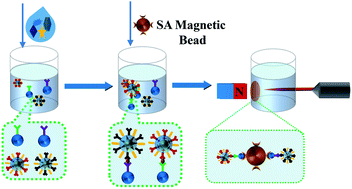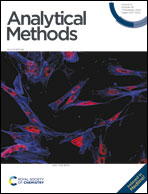SERS-based magnetic immunoassay for simultaneous detection of cTnI and H-FABP using core–shell nanotags
Abstract
Acute myocardial infarction (AMI) is the single leading cause of worldwide mortality and morbidity. Heart-type fatty acid-binding protein (H-FABP) and cardiac troponin I (cTnI), as biomarkers emerging at different stages of AMI, have complementary advantages in terms of specificity and sensitivity. Therefore, we developed a magnetic immunoassay method based on surface-enhanced Raman scattering (SERS) to detect H-FABP and cTnI simultaneously. Herein, two mutually independent Raman reporter molecules were embedded between a gold core and silver shell and then combined with a tracer antibody to form a SERS immunoprobe. During detection, the SERS immunoprobe, target antigen and capture probe undergo an immune reaction to form a sandwich structure, and then the immune complex was enriched by a specific reaction of streptavidin on the surface of magnetic beads with biotin. Finally, the concentration of biomarkers was quantified by detecting the characteristic Raman peak intensities of the two Raman reporter molecules. Under the optimized conditions, the minimum detection limits of H-FABP and cTnI were 0.6396 and 0.0044 ng mL−1, respectively. Besides, the target antigen does not cross-react with non-specific proteins, showing good specificity. Therefore, our proposed SERS-based magnetic immunoassay method has the advantages of accuracy, rapidity and good selectivity, and has great potential for early diagnosis of acute myocardial infarction disease.

- This article is part of the themed collection: Analytical Methods Recent HOT articles


 Please wait while we load your content...
Please wait while we load your content...